A Comprehensive Overview to 'Secondary Dimensions' in Google Analytics: Insights Revealed
Navigating the Midst of Second Measurement in Google Analytics: A Thorough Exploration on Its Functionality
In the world of electronic analytics, the details of information interpretation often hold the trick to opening valuable insights. Within the expansive toolkit of Google Analytics exists a feature that functions as a surprise gem for those that look for a deeper understanding of customer actions and web site performance. Secondary measurements, though seemingly uncomplicated in the beginning glimpse, harbor a wide range of untapped possible waiting to be utilized. As we start this journey to explore the nuanced performance of secondary measurements, we will uncover just how this feature can illuminate patterns, reveal connections, and inevitably pave the means for informed decision-making in the digital landscape.
Recognizing Secondary Dimensions in Google Analytics

Comprehending just how second measurements job is essential for leveraging the full power of Google Analytics. By combining key metrics with second dimensions, you can obtain beneficial understandings that drive informed decision-making and optimization approaches.
Leveraging Second Measurements for Information Evaluation
Structure upon the fundamental understanding of how second measurements enhance data evaluation in Google Analytics, the utilization of these additional layers of information ends up being vital in extracting beneficial understandings for informed decision-making and optimization strategies. By leveraging second dimensions, analysts can dig deeper right into the efficiency metrics by including more context to the main measurements, therefore discovering covert patterns and correlations that could not appear initially look. This much deeper level of analysis allows services to better comprehend customer behavior, determine trends, and determine locations for improvement.
Moreover, secondary dimensions supply a more detailed view of the data, permitting segmentation based on different criteria such as demographics, tools, website traffic sources, and more. This division promotes a more granular evaluation, making it possible for businesses to tailor their campaigns and techniques to certain audience segments for boosted targeting and customization. Fundamentally, the calculated use of secondary measurements empowers organizations to make data-driven decisions that drive development and success in the electronic landscape.
Advanced Techniques for Additional Measurement Implementation
Discovering detailed techniques to harness the complete possibility of additional dimensions in Google Analytics boosts the depth and elegance of data evaluation for calculated decision-making. One sophisticated method for implementing additional measurements is using custom dimensions. By specifying personalized measurements, customers can sector data better to acquire even more certain insights right into individual habits, such as tracking interactions with particular elements on a page or keeping track of the efficiency of a certain advertising and marketing project. Another sophisticated approach is the application of regex (routine expressions) within additional dimensions. Regex enables for more powerful and adaptable pattern matching, making it possible for customers to develop complicated filters for information analysis. Furthermore, integrating additional measurements with innovative sectors can give even more granular understandings by using multiple layers of segmentation to the data. This method enables for a much deeper understanding of individual actions based on numerous criteria at the same time. Applying these advanced methods for secondary dimensions in Google Analytics equips users to perform extra innovative analysis and make data-driven decisions with precision.
Interpreting Insights With Additional Measurements
When analyzing insights via additional measurements, it is important to consider the context of the data and just how various measurements communicate with each other. For instance, understanding which certain traffic resources cause greater conversion rates or recognizing which tools customers prefer for making purchases can offer actionable insights for enhancing advertising campaigns and enhancing overall internet site performance. By Find Out More carefully checking out the data with additional measurements in mind, companies can make educated decisions that drive purposeful outcomes and boost their electronic visibility.
Optimizing Efficiency With Additional Dimensions
One crucial method to maximize efficiency with secondary measurements is by segmenting data a lot more granularly. This enables you to isolate specific factors that might be find here affecting your metrics and obtain a much better understanding of what drives success or failing in your digital initiatives. For instance, by incorporating second dimensions such as 'gadget category' and 'landing web page,' you can determine which device kinds are most efficient for specific landing web pages, enabling you to customize your strategies appropriately.
Furthermore, using second measurements can aid you determine trends, patterns, and relationships that may not appear when evaluating information with primary measurements alone. This much deeper level of evaluation can cause even more informed decision-making and ultimately boost the general efficiency of your site or electronic advertising projects.
Conclusion
To conclude, secondary dimensions in Google Analytics play a vital duty in improving information analysis and providing much deeper understandings into website performance. By utilizing innovative methods and analyzing the data successfully, organizations can optimize their approaches and boost overall efficiency. Recognizing the performance of second measurements is necessary for making educated choices and driving success in the electronic landscape.
By leveraging additional measurements, experts can dive much deeper into the efficiency metrics by including more context to the primary measurements, hence revealing concealed patterns and relationships that may not be evident at first glimpse. One sophisticated method for executing secondary dimensions is the use of custom dimensions.Having actually mastered advanced strategies like customized dimensions and regex for additional measurement implementation in Google Analytics, the next essential action is analyzing the beneficial understandings derived via these innovative information division techniques. Analyzing understandings via secondary measurements entails examining the connections in between see post the second and key dimensions picked, discovering patterns, patterns, and correlations that may not be promptly obvious when looking at the information in its whole.When translating insights via second measurements, it is necessary to think about the context of the information and just how different measurements interact with each other.